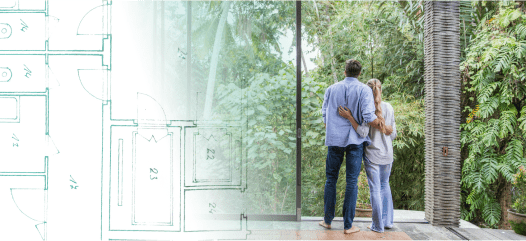What is Homeowners Insurance?
September 10, 2019 — 4 min read
The journey to homeownership is no easy trek. There will be an endless list of new terms and information that come up during the loan process, and even afterward. An important part of being a homeowner is knowing the ins and outs of homeowners insurance.
A standard homeowners insurance policy will provide you with financial protection in the event of a disaster or accident involving your home's structure and belongings inside. Let's look at some common questions about homeowners insurance and break it down together.
Is homeowners insurance required?
Technically, homeowners insurance is not required by law. However, most lenders will require you to have at least some form of basic insurance to fund a loan. Once you pay off your mortgage and you own the home outright, you don't have to keep your insurance. But there are plenty of reasons to keep it.
What does homeowners insurance cover?
Your homeowners insurance will reimburse you for living expenses if you're forced to live outside of your home during repairs, in addition to the home and personal property coverage. (Given the cause of damage is a covered peril in your policy.)
A named-peril policy will only cover the perils specifically outlined in your policy. An open peril policy will cover everything except the hazards specifically listed in your policy.
There are eight different forms of homeowners insurance, but there are five options for basic homeownership (not a condo or mobile home, etc):
HO1: Basic Form (Limited Coverage Policy)
This form of homeowners insurance offers the most limited coverage. Because it's a named peril policy, only the perils outlined in your policy are covered. Perils:
- Fire/Lightning
- Windstorm/Hail
- Vandalism
- Malicious mischief
- Vehicles
- Aircraft
- Explosions/Riots
- Glass breakage
- Smoke
- Volcanic eruption
- Personal liability
HO2: Broad Form (Basic Policy)
All perils listed under HO1 are included in this form, in addition to:
- Falling objects
- Weight of ice, snow, and sleet
- Accidental discharge or overflow of water/steam
- Sudden and accidental tearing apart, cracking, burning, bulging
- Freezing
- Sudden, accidental damage from artificially generated electrical current
HO3: Special Form (Most Common Policy)
This is considered the most common type of homeowners insurance because of its broad range of coverage, and the fact that it's generally still affordable for homeowners. HO3 is an open peril policy. Some common exclusions you will see on an open peril policy include:
- Earth Movement
- Ordinance of law
- Power failure
- War
- Nuclear hazard
- Government action
- More
HO5: Comprehensive Form
An HO5 policy will cover more perils than the previous types listed. Similar to an HO3, an HO5 is an open peril policy. Whereas an HO3 policy has named perils for personal property, HO5 policies are open peril for both the dwelling and personal property.
HO8: Older Home Form
This form of homeowners insurance is designed for homes built more than 40 years ago and don't meet all of the structural update requirements found in HO3 policies. HO8 policies are peril plans that provide the same basic coverage as HO1 policies.
Most basic forms of homeowners insurance will not cover flood or earthquake damage. A standalone policy may be needed for your home if you live in areas prone to these types of damage.
How much does homeowners insurance cost?
The average premium for homeowners insurance in 2016 was about $100/month ($1,192 annually.) However, your cost will vary on location, provider, and extensiveness of the policy.
It's important that you don't confuse homeowners insurance and mortgage insurance. Homeowners insurance exists to protect the homeowner in the event of damage to your home. Whereas mortgage insurance exists to protect the lender in the event that you (the borrower) cannot repay your loan.
How do I buy homeowners insurance?
When it comes time to buy insurance, there are a few important steps you have to take before you go shopping. First, you'll need to get a replacement cost estimate of your home from a certified appraiser. This estimate will help ensure you get the most from your insurance policy.
Next, you should take inventory of your personal items, including any valuables you may need coverage for. To understand just how much coverage you'll need, combine your total assets.
It's no secret that you should never go with the first company you find. So, take time to do your research, and ask people you know for recommendations. You should also get multiple quotes and check for possible discounts.
Are you ready to begin the homeownership journey? Contact a Mortgage Advisor today.
Categories
Archives
Recent Posts
You bring the dream. We'll bring the diagram.
There’s a financing solution for just about every situation.
I felt like I was treated like family, great communication and helping me with any questions I had.

You bring the dream. We'll bring the diagram.
There’s a financing solution for just about every situation.
Where does your sun shine? Find your local advisor.
Enter your city or state to see advisors near you.
